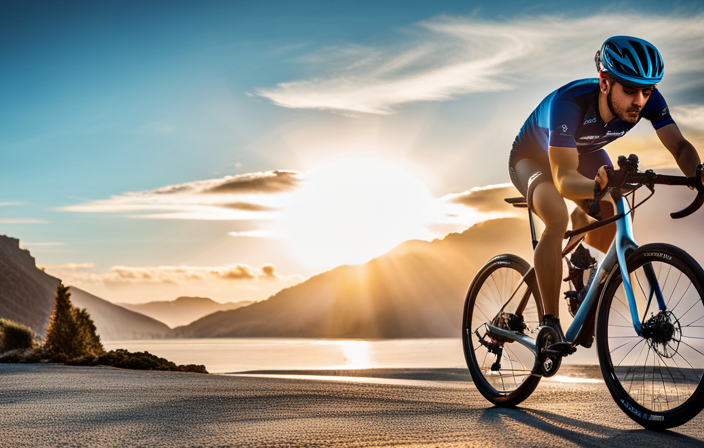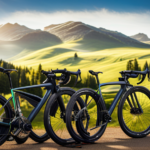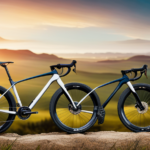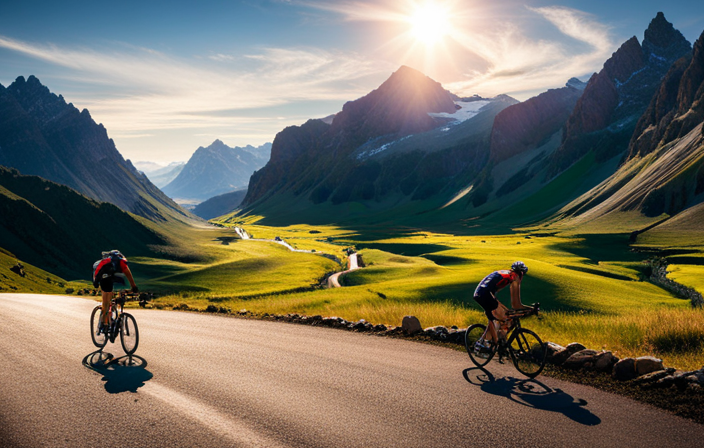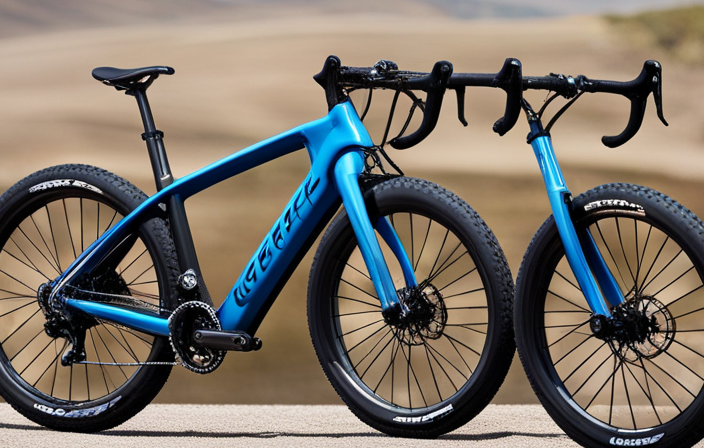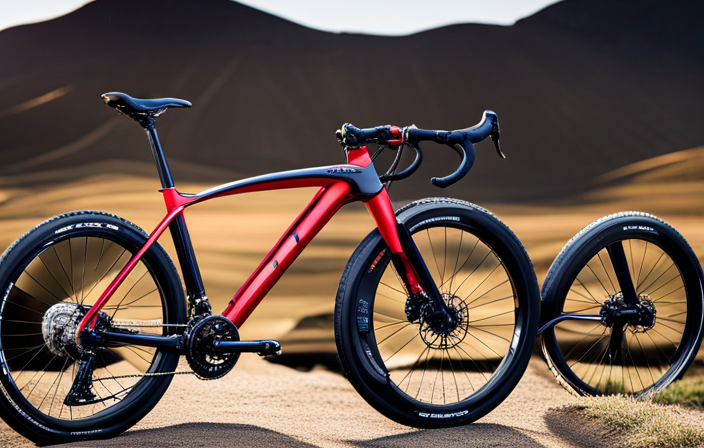Cycling on a gravel bike resembles performing a tightrope walk, where one must find the perfect equilibrium between velocity and managing rough grounds.
In this article, we delve into the world of gravel biking to explore just how fast you can go.
From understanding the unique features of gravel bikes to tackling uphill challenges and descending with confidence, we’ll analyze the factors that impact your speed.
So grab your helmet and join me as we discover the exhilarating potential of pushing our limits on a gravel bike.
Key Takeaways
- Gravel bikes are designed for various terrains and require lightweight and good traction for speed.
- Factors such as tubeless tires, aerodynamic components, and optimized tire pressure can improve speed on flat terrain.
- Uphill challenges can be navigated by adjusting gear selection, leaning forward, and pacing oneself to conserve energy.
- Descending with speed and control requires proper body positioning, wider tires with aggressive tread, and practicing smooth lines for momentum and control.
Understanding Gravel Bikes
How fast can you go on a gravel bike? Well, it depends on several factors, including your fitness level and the type of terrain you’re riding on. Gravel bikes are designed to handle a variety of surfaces, from smooth dirt roads to rough gravel paths. When it comes to bike selection, there are a few things to consider.
First, make sure you choose a bike that is lightweight and has good traction. This will allow you to maintain speed and control on different terrains.
Additionally, investing in the right gravel bike accessories can also improve your speed. For example, tubeless tires can reduce rolling resistance and increase efficiency. Aerodynamic components like handlebars and helmets can also make a difference when it comes to speed.
Now let’s talk about the factors that impact your speed on a gravel bike. One important factor is the condition of the road or trail you’re riding on. Rougher surfaces with loose gravel will naturally slow you down compared to smoother paths. The weather conditions also play a role; strong headwinds or wet surfaces can affect your speed as well.
In conclusion, while there isn’t an exact answer to how fast you can go on a gravel bike, choosing the right bike and accessories and considering external factors will help maximize your speed and performance.
Factors That Impact Speed
Factors such as terrain, tire width, and gear ratio significantly affect your speed on a gravel bike. The table below illustrates how each factor impacts your riding experience:
| Factor | Impact on Speed |
|---|---|
| Terrain | Rough and hilly terrain slows you down as you navigate through bumps and obstacles. Flat or downhill sections allow for faster speeds. |
| Tire Width | Wider tires provide better traction on loose surfaces, but they also increase rolling resistance, making it harder to maintain high speeds. Narrower tires reduce rolling resistance but may compromise grip on challenging terrain. |
| Gear Ratio | A lower gear ratio is ideal for climbing steep hills or navigating rough terrains with ease, but it limits your top speed on flat stretches. Higher gear ratios are more suitable for maintaining higher speeds. |
In addition to bike setup, weather conditions play a crucial role in determining how fast you can go on a gravel bike. Wet or muddy conditions decrease traction and make it harder to maintain control at high speeds. Strong headwinds can also slow you down significantly.
Considering these factors, we can now transition into discussing top speeds on flat terrain without missing a beat.
Top Speeds on Flat Terrain
When riding on flat terrain, your maximum speed will be determined by various factors such as bike setup, weather conditions, and the type of surface you are riding on. One important factor to consider is bike aerodynamics. Gravel bikes are designed with a more relaxed geometry compared to road bikes, which allows for a more comfortable riding position but can impact speed. To increase your top speed on flat terrain, it’s essential to optimize your bike’s aerodynamics by minimizing wind resistance. This can be achieved by tucking in your elbows and lowering your torso closer to the handlebars.
Another crucial element that affects speed is tire pressure. Finding the optimal tire pressure for gravel riding is key to maximizing efficiency and reducing rolling resistance. It’s important to strike a balance between grip and low rolling resistance when determining tire pressure. Experiment with different pressures based on the specific conditions of the surface you’re riding on.
By understanding these factors and making appropriate adjustments, you can achieve higher speeds on flat terrain with a gravel bike. With optimized aerodynamics and the right tire pressure, you’ll be able to ride faster while maintaining control over your bike.
Transitioning into navigating uphill challenges: As we explore how fast you can go on a gravel bike, it’s also essential to address the unique challenges posed by uphill sections of the route without compromising speed or performance.
Navigating Uphill Challenges
To tackle uphill challenges on your gravel ride, it’s important to adjust your riding technique and gear selection accordingly. Navigating steep inclines requires a combination of physical strength and smart pacing strategies.
As you approach an uphill section, shift into a lower gear to maintain a steady cadence and prevent burning out too quickly. This will help you conserve energy for the climb ahead.
When facing a steep incline, it’s crucial to maintain balance and traction. Keep your weight centered over the bike by leaning forward slightly while gripping the handlebars firmly. This will allow you to distribute your weight evenly between the front and rear wheels, providing better stability on uneven terrain.
Pacing is key when climbing hills on a gravel bike. Instead of going all-out at the beginning, try to find a sustainable rhythm that suits your fitness level. Focus on maintaining a consistent effort throughout the ascent, adjusting your speed as needed without pushing yourself too hard.
By mastering these techniques and finding your own optimal pacing strategy, you’ll be able to conquer even the most challenging uphill sections on your gravel bike. With this newfound confidence in tackling ascents, you’ll soon be ready to descend with speed and control effortlessly.
Descending with Speed and Control
Mastering the art of descending on your gravel bike requires balancing speed and control. When it comes to descending techniques, body positioning plays a crucial role. To maintain stability and control, I position my body slightly back, with my weight evenly distributed between my hands and feet. This allows me to better absorb bumps and maintain traction on loose terrain.
Another important factor in descending with speed and control is choosing the right tires. Optimal control can be achieved by selecting wider tires with aggressive tread patterns that provide good grip on gravel roads. These tires increase surface contact, enhancing stability while going downhill at high speeds.
In addition to body positioning and tire selection, I also pay close attention to my line choice when descending. By taking smooth, sweeping lines around corners instead of sharp turns, I can maintain momentum while minimizing the risk of skidding or losing control.
As I transition into pushing the limits on technical terrain, it’s important to remember that mastering descents requires practice and experience. By honing these skills and continually challenging myself, I can confidently navigate any downhill section with both speed and control.
Now let’s move onto pushing the limits on technical terrain without compromising safety.
Pushing the Limits on Technical Terrain
Pushing the limits on technical terrain requires a combination of skill, experience, and a keen sense of balance. When it comes to tackling challenging trails with my gravel bike, there are a few key factors that contribute to my success.
-
Technical Skills: Riding on technical terrain demands advanced bike handling skills. Being able to maneuver through tight corners, navigate rocky sections, and maintain control over loose surfaces is crucial. It takes practice and patience to develop these skills, but they are essential for pushing the limits on technical terrain.
-
Bike Setup: Having the right setup on your gravel bike can make all the difference when riding technical trails. Opting for wider tires with aggressive tread patterns provides better traction and stability. Additionally, adjusting tire pressure can further enhance performance by improving grip on different surfaces.
-
Body Positioning: Proper body positioning plays a significant role in maintaining balance and control on technical terrain. Keeping my weight centered over the bike allows me to easily handle obstacles such as rocks or roots without losing momentum.
-
Choosing Lines: Selecting the right line is crucial when navigating technical terrain. Identifying smooth paths through rough sections helps maintain speed while minimizing impact on both myself and the bike.
By honing my technical skills and optimizing my bike setup, I can confidently push the limits on challenging gravel trails.
Now let’s explore how these skills translate into conquering gravel races and events…
[Transition sentence]: As I continue to improve my abilities on technical terrain, I find myself yearning for new challenges in gravel races and events where I can put these skills to the test even further.Exploring Gravel Races and Events
When exploring gravel races and events, it’s important to challenge yourself and put your skills to the test. These races offer a unique opportunity to push the limits of what you can do on a gravel bike. One key aspect to consider is gravel bike technology. Having the right equipment can make a big difference in your performance during these events. Upgrading your tires, for example, can provide better traction and control on rough terrain.
Nutrition and hydration are also crucial factors in gravel racing. The longer distances and challenging conditions require careful planning to ensure you stay fueled and hydrated throughout the race. It’s important to pack enough water or sports drinks, as well as snacks that provide sustained energy.
As I transition into discussing safety precautions and gear, it’s worth noting that participating in gravel races is not just about speed and pushing boundaries; it’s also about staying safe. Having proper safety gear such as a helmet, gloves, knee pads, and elbow pads is essential. Additionally, familiarize yourself with the route beforehand and be prepared for any unexpected challenges that may arise.
In conclusion, exploring gravel races provides an exciting opportunity to test your skills on a gravel bike. By understanding the importance of gravel bike technology and prioritizing nutrition and hydration during these events, you can maximize your performance while ensuring safety remains a top priority.
Safety Precautions and Gear
To ensure a safe experience during gravel races and events, it is essential to prioritize the use of proper safety gear. This includes a helmet, gloves, knee pads, and elbow pads. These bike accessories provide crucial protection in case of any accidents or falls that may occur on rugged terrain. Investing in a high-quality helmet is non-negotiable as it protects your head from potential injuries and can be life-saving in the event of a crash. Gloves offer grip and cushioning while also protecting your hands from cuts and abrasions. Knee pads and elbow pads provide an extra layer of protection for joints that are vulnerable to impact during falls.
Additionally, it is important to consider other safety measures such as wearing reflective clothing. This enhances visibility for both yourself and other riders. When participating in gravel races or events, it is also worth considering other bike accessories like lights or reflectors. These increase visibility when riding in low-light conditions or at night, reducing the risk of collisions with vehicles or fellow riders.
By prioritizing the use of proper safety gear and incorporating additional precautions like reflective clothing and lights, you can significantly reduce the chances of injuries while enjoying gravel races and events.
Transitioning into the subsequent section about training and conditioning, it is equally important to prepare physically for these demanding rides through adequate training methods.
Training and Conditioning
When it comes to training and conditioning for gravel biking, there are three key points that I focus on:
-
Building endurance and stamina: This is crucial for long rides, so I incorporate longer rides into my training plan to gradually increase my time in the saddle.
-
Strength training: It’s important for powering through challenging terrain, so I include exercises like squats, lunges, and deadlifts to build leg strength.
-
Incorporating interval training: This helps improve speed and power on the bike, so I incorporate high-intensity intervals into my workouts to push myself outside of my comfort zone.
By focusing on these key points in my training routine, I have seen significant improvements in my performance on the gravel bike.
Building endurance and stamina
If you want to build endurance and stamina, you can gradually increase your cycling duration on a gravel bike. Incorporating effective training techniques and nutrition strategies is essential for achieving optimal results.
When it comes to training, interval workouts are highly beneficial for improving cardiovascular fitness and increasing endurance. By alternating between high-intensity efforts and recovery periods, you can push your body’s limits and improve its ability to sustain effort over long durations.
Additionally, incorporating longer rides into your training routine will help condition your muscles and cardiovascular system for the demands of gravel biking. It’s also important to fuel your body properly with a balanced diet that includes carbohydrates, proteins, and healthy fats. This will provide the energy needed for endurance rides and aid in muscle recovery.
Transitioning into the subsequent section about strength training for gravel biking, it’s crucial to incorporate exercises that target key muscle groups used during cycling.
Strength training for gravel biking
One way to improve your performance on gravel rides is by incorporating strength training exercises that target the key muscle groups used during cycling. By focusing on building strength in your legs, core, and upper body, you can enhance your power output and endurance on the bike.
To get started with strength training for gravel biking, consider incorporating techniques such as squats, lunges, deadlifts, and planks into your routine. These exercises engage multiple muscle groups simultaneously and help improve overall stability and balance while riding.
Additionally, it’s important to fuel your body properly with the right nutrition for gravel biking. Adequate protein intake is crucial for muscle recovery and growth, while carbohydrates provide the energy needed for long rides.
Incorporating interval training into your routine can further enhance your performance on gravel rides without writing ‘step’.
Incorporating interval training into your routine
Another effective way to improve your performance on gravel rides is by incorporating interval training into your routine. Interval training involves alternating between high-intensity bursts of effort and periods of active recovery. This type of training can benefit gravel bikers in several ways.
Firstly, it helps build both aerobic and anaerobic fitness levels, allowing you to sustain higher speeds for longer durations. Secondly, interval training improves your ability to handle surges and changes in pace that are common on gravel terrain.
To incorporate interval training into your routine, you can try different techniques such as Tabata intervals or hill repeats. Tabata intervals involve 20 seconds of all-out effort followed by 10 seconds of rest, repeated for a total of four minutes. Hill repeats involve sprinting up a hill at maximum effort and then recovering by descending or riding at an easier pace.
By incorporating these interval training techniques into your routine, you can enhance your speed and endurance on gravel rides.
Now that we’ve covered how to improve our performance through interval training, let’s transition into the next section about bike maintenance and care without skipping a beat in our ride!
Bike Maintenance and Care
When it comes to bike maintenance and care, it’s important to regularly clean and lube the chain. Bike cleaning is a crucial aspect of keeping your gravel bike in top shape. After every ride, I make sure to thoroughly clean my bike using a mild soap and water mixture. This helps remove any dirt, mud, or grime that may have accumulated during the ride. Additionally, I pay close attention to the chain and cassette, using a degreaser to remove any built-up grease or debris.
Another key aspect of maintenance is puncture repair. It’s inevitable that at some point you’ll get a flat tire while riding on gravel roads. That’s why I always carry a puncture repair kit with me on rides. This includes spare inner tubes, tire levers, and a pump or CO2 inflator. Being prepared for these situations allows me to quickly fix any flats and get back on the road.
Learning from the experts is also crucial in maintaining your bike properly without missing any essential steps. By attending workshops or watching online tutorials, I’ve learned valuable tips and tricks from experienced cyclists who know all about keeping bikes in optimal condition.
Transitioning into the next section about learning from the experts doesn’t require mentioning ‘step’, as we can smoothly move into discussing this topic further.
Learning from the Experts
In this section, I will be discussing the valuable insights that can be gained from interviews with experienced gravel riders, tips and advice shared by professional cyclists, and the knowledge offered by gravel bike manufacturers.
Through these interactions, I have been able to gather a wealth of information on how to improve my skills as a gravel rider. The interviews have provided me with real-life experiences and strategies that I can apply to my own rides, while the tips from professionals have helped me refine my technique.
Additionally, learning about the design and features of gravel bikes directly from manufacturers has given me a deeper understanding of how to optimize performance on different terrains.
Interviews with experienced gravel riders
Try interviewing experienced gravel riders to gather insights on how fast you can go on a gravel bike. Their knowledge and experience can provide valuable information about the capabilities of these bikes. In my conversations with seasoned riders, I discovered that speed on a gravel bike depends on various factors such as terrain, fitness level, and equipment. To give you an idea of what I learned, here is a table summarizing their insights:
| Factors | Impact |
|---|---|
| Terrain | Rough surfaces may slow you down, while smoother paths allow for faster speeds. |
| Fitness Level | The fitter you are, the faster you can pedal and maintain speed. |
| Equipment | Proper maintenance and accessories for your gravel bike contribute to better performance. |
These interviews shed light on the factors influencing speed while riding a gravel bike. Now let’s delve into tips and advice from professional cyclists to further enhance our understanding of this topic.
Tips and advice from professional cyclists
Professional cyclists offer valuable tips and advice to enhance your understanding of riding a gravel bike at optimal speeds. Here are three key insights from the pros:
-
Incorporate interval training into your routine: Interval training helps improve your speed and endurance on gravel roads. By alternating between high-intensity bursts and recovery periods, you can simulate the demands of riding off-road and build up your fitness levels.
-
Focus on nutrition strategies: To maintain peak performance, it’s essential to fuel your body with the right nutrients. Prioritize a well-balanced diet that includes carbohydrates for energy, protein for muscle repair, and hydration for endurance. Additionally, consider incorporating energy gels or bars during longer rides to sustain energy levels.
-
Master bike handling skills: Gravel riding requires excellent bike handling skills due to unpredictable terrain. Practice cornering, descending, and navigating loose surfaces to gain confidence and improve control.
By implementing these training techniques and nutrition strategies, you’ll be better equipped to maximize your speed on a gravel bike.
Next, we’ll explore insights from gravel bike manufacturers without missing a beat.
Insights from gravel bike manufacturers
To get the most out of your gravel riding experience, take note of the insights shared by manufacturers in the industry.
When it comes to gravel bike maintenance, it’s important to regularly clean and lubricate your drivetrain to ensure smooth shifting and optimal performance. Additionally, manufacturers recommend checking your tires for any signs of wear or damage before each ride.
Choosing the right tire selection is crucial for maximizing speed and control on gravel surfaces. Many manufacturers offer specific gravel tires that feature a durable tread pattern for enhanced grip and puncture protection.
By following these maintenance tips and selecting the appropriate tires for your gravel bike, you can enhance your overall riding experience.
Now let’s transition into setting personal speed goals without delay.
Setting Personal Speed Goals
Setting personal speed goals on a gravel bike is essential for tracking progress and pushing oneself to improve. By setting achievable targets, riders can have a clear focus and motivation to work towards. Here are three key reasons why setting personal speed goals is important:
-
Motivation: Having a specific goal in mind can provide the necessary motivation to push through challenging rides and training sessions. Whether it’s aiming for a certain average speed or completing a distance within a specific time frame, these goals keep riders focused and determined.
-
Measuring Progress: Setting personal speed goals allows riders to track their improvement over time. By regularly monitoring their speeds on different terrains or during various workouts, riders can see how they’re progressing and identify areas that need more attention.
-
Challenging Yourself: Personal speed goals give riders the opportunity to challenge themselves beyond their comfort zone. Pushing beyond familiar limits helps in increasing endurance and building confidence as well as pushing overall performance boundaries.
By setting realistic targets, tracking progress becomes easier, allowing individuals to celebrate achievements while identifying areas for growth. This approach helps create a sense of community and support where experiences are shared, strategies discussed, and tips exchanged with fellow gravel bike enthusiasts looking to improve their riding skills further.
Community and Support
When it comes to community and support in the world of gravel biking, there are several key points to consider.
First, joining gravel bike clubs and groups is a great way to connect with like-minded individuals who share your passion for riding on gravel roads. These clubs often organize group rides, events, and races that can help you improve your skills and meet new people.
Second, online forums and resources specifically for gravel bikers provide a wealth of information on everything from bike maintenance to route suggestions. These platforms allow you to ask questions, share experiences, and learn from others in the community.
Finally, finding training partners and riding buddies can be essential for staying motivated and pushing yourself further. Whether it’s joining organized group rides or reaching out to fellow riders in your area, having someone to ride with can make the experience more enjoyable and help you achieve your goals faster.
Joining gravel bike clubs and groups
Joining gravel bike clubs and groups allows you to connect with fellow riders and discover new routes. It’s a great way to enhance your gravel bike fitness and explore different terrains. Here are some benefits of joining these communities:
-
Supportive Environment: Gravel bike clubs provide a welcoming atmosphere where you can meet like-minded individuals who share your passion for riding.
-
Knowledge Sharing: Interacting with experienced riders in these groups gives you access to valuable information about the best gravel bike routes and training tips.
-
Group Rides: Riding with others not only adds an element of fun but also helps improve your skills as you learn from more seasoned cyclists.
-
Safety in Numbers: Joining a club ensures that you have support during rides and someone to help out if anything goes wrong.
-
Social Connections: Building friendships within these communities creates a sense of camaraderie, making every ride even more enjoyable.
By participating in gravel bike clubs, you’ll be well-prepared to explore online forums and resources for gravel bikers.
Online forums and resources for gravel bikers
To enhance your knowledge and connect with fellow gravel bikers, check out online forums and resources specifically designed for enthusiasts like yourself. These online platforms provide a wealth of information on various topics related to gravel biking, including gear recommendations, maintenance tips, route suggestions, and race reports.
You can join discussions, ask questions, and share your own experiences with other passionate riders. Additionally, many websites offer comprehensive reviews of gravel bike gear, helping you make informed decisions when purchasing equipment. These resources also often feature classified sections where you can buy or sell used gear at affordable prices.
By participating in these online communities, you can expand your knowledge about gravel biking while connecting with like-minded individuals who share your passion for adventure on two wheels.
Now that you have access to valuable information from online resources and forums dedicated to gravel biking and have equipped yourself with the right gear, it’s time to find training partners and riding buddies.
Finding training partners and riding buddies
Looking for training partners and riding buddies? Finding riding buddies can greatly enhance your gravel biking experience. Not only can they provide motivation and support, but they can also help you discover new routes and techniques.
One way to find riding buddies is by joining local cycling groups or clubs. These groups often organize group rides where you can meet like-minded individuals who share your passion for gravel biking.
Another option is to explore online platforms dedicated to connecting cyclists, such as social media groups or forums. Here, you can connect with other riders in your area and arrange rides together. Riding with a group not only adds an element of camaraderie but also ensures safety in numbers.
So, once you’ve found your riding buddies, it’s time to push your limits safely and explore how fast you can go on a gravel bike without compromising your well-being.
Transitioning into the subsequent section: Now let’s delve into the importance of pushing your limits safely while exploring the capabilities of a gravel bike.
Pushing Your Limits Safely
When it comes to pushing my limits on a gravel bike, I always prioritize knowing my limits and avoiding unnecessary risks.
It’s important to gradually increase speed and difficulty, allowing myself time to adapt and build confidence along the way.
While challenging myself is essential for growth, I also make sure to stay within my comfort zone, finding that sweet spot where I can push myself while still feeling in control.
Knowing your limits and avoiding unnecessary risks
Be aware of your limits and avoid unnecessary risks when riding on a gravel bike. It’s important to prioritize safety and prevent potential injuries.
One way to do this is by assessing the trail conditions before embarking on your ride. Take note of any obstacles such as loose gravel, potholes, or steep descents that may pose a risk. Adjust your speed accordingly and maintain control over your bike at all times.
Additionally, it’s crucial to know your own capabilities and not push yourself beyond what you can handle. Recognize when you’re starting to feel fatigued or mentally overwhelmed and take breaks as needed. Remember, pushing too hard can lead to accidents or diminished performance.
By being mindful of these factors and making informed decisions, you’ll be able to enjoy your gravel biking experience while minimizing unnecessary risks. As you become more comfortable with the terrain, gradually increase both your speed and the difficulty level of the trails you tackle next.
Gradually increasing speed and difficulty
As I mentioned before, knowing your limits and avoiding unnecessary risks is crucial when it comes to riding a gravel bike. But once you have a solid foundation, it’s time to start pushing yourself and gradually increasing the intensity. Speed training techniques can help you improve your performance and take your gravel biking to the next level. By incorporating interval training, hill repeats, and tempo rides into your routine, you can enhance your cardiovascular endurance and leg strength. Additionally, practicing handling skills on technical terrain will boost your confidence and allow you to navigate challenging trails at higher speeds. However, it’s important to stay within your comfort zone while still challenging yourself in order to maintain control and minimize the risk of accidents or injuries. So let’s explore how we can strike that balance in the upcoming section about ‘staying within your comfort zone while still challenging yourself.’
Staying within your comfort zone while still challenging yourself
Find the right balance between pushing yourself and staying comfortable to ensure a safe and enjoyable gravel biking experience.
When it comes to staying motivated and challenging yourself, mental preparation is key. It’s important to set realistic goals that push your limits but also take into account your current fitness level and skillset.
Start by gradually increasing your speed and difficulty, but always listen to your body and know when to dial it back if needed. Pushing too hard can lead to fatigue or injury, so it’s crucial to stay within your comfort zone while still challenging yourself.
By doing so, you’ll maintain the motivation to keep improving without risking burnout or setbacks.
As we move into the next section about enjoying the ride, remember that finding this balance is essential for a fulfilling gravel biking experience.
Enjoying the Ride
Feel the joy of the ride as you cruise along on your gravel bike. There’s something truly special about being out in nature, exploring new trails, and feeling the wind against your face. Riding a gravel bike allows you to experience all of this while finding inner peace.
One of the greatest aspects of riding a gravel bike is the opportunity to enjoy nature. As you pedal through forests, fields, and mountains, you’re surrounded by breathtaking scenery. The sights and sounds of nature become your companion as you navigate through challenging terrains. It’s an immersive experience that allows you to appreciate the beauty around you in a way that other forms of transportation simply can’t match.
Additionally, riding a gravel bike can help you find inner peace. The rhythmic motion of pedaling combined with being immersed in nature creates a sense of tranquility that is hard to replicate elsewhere. There’s something meditative about focusing solely on the road ahead and letting go of any worries or stressors from daily life. It’s a chance to escape from the noise and chaos and connect with yourself on a deeper level.
So, hop on your gravel bike and embark on an adventure filled with enjoying nature and finding inner peace. Let the ride take you wherever it may lead, and embrace every moment as you explore new trails and push yourself beyond your comfort zone. Remember, it’s not just about how fast you can go on a gravel bike; it’s about savoring each pedal stroke and relishing in the pure joy of the journey itself.
Frequently Asked Questions
What are the different types of gravel races and events that cyclists can participate in?
There are various types of gravel bike races and events that cyclists can participate in. Some popular ones include endurance races, where riders cover long distances on challenging terrain, and gravel grinder events, which focus on testing a cyclist’s stamina and bike handling skills.
Additionally, there are gravel fondo rides, which offer a more relaxed atmosphere for riders to enjoy the scenic routes.
To enhance their performance in these races, cyclists can invest in gravel bike accessories like tubeless tires, handlebar bags, and extra bottle cages.
What are some essential safety precautions and gear that gravel bike riders should consider?
Essential safety precautions for gravel bike riders include:
- Wearing a properly fitted helmet to protect the head.
- Using lights and reflective gear for visibility.
- Obeying traffic laws.
It’s crucial to be mindful of road conditions, such as loose gravel or potholes, and adjust speed accordingly.
Gear recommendations include:
- Sturdy tires with good traction.
- Gloves for hand protection.
- Knee and elbow pads for added safety.
- A hydration pack to stay hydrated during long rides.
Are there any specific training or conditioning exercises that can help improve speed on a gravel bike?
Training techniques are crucial for improving speed on a gravel bike. To achieve this, I recommend incorporating interval training into your routine. This involves alternating between high-intensity bursts and recovery periods.
Additionally, hill repeats can help build strength and endurance, as they simulate the challenging terrain of gravel riding.
Furthermore, focusing on leg strength through exercises like squats and lunges will enhance your pedaling power.
With these training methods, you’ll be well-equipped to conquer any gravel road with increased speed and efficiency.
What are some common bike maintenance and care practices that gravel bike owners should follow?
When it comes to bike maintenance and care practices for gravel bike owners, there are a few key things to keep in mind.
Regularly cleaning the bike after riding on gravel roads is essential to prevent dirt and debris from causing damage.
Additionally, checking tire pressure, lubricating the chain, and inspecting brake pads are important tasks.
It’s also crucial to periodically examine the frame for any signs of cracks or damage.
Following these practices will ensure your gravel bike stays in optimal condition for longer rides.
How can cyclists learn from experts in the field to enhance their gravel biking skills and performance?
If you want to enhance your gravel biking skills and performance, there’s no better way than learning from the experts. Their tips can make a world of difference in your riding experience.
From mastering advanced gravel bike techniques to improving overall performance, their insights are invaluable. By incorporating their advice into your training routine, you’ll be able to navigate challenging terrains with ease and boost your confidence on the trails.
So seek out these experts and soak up their knowledge to take your gravel biking to new heights!
Conclusion
In conclusion, the world of gravel biking offers endless possibilities for speed enthusiasts like me. From understanding the nuances of gravel bikes to navigating various terrains, there are plenty of factors that impact our speed.
Whether we’re conquering flat terrain, pushing ourselves uphill, or descending with control, it’s important to set personal speed goals and push our limits safely.
Remember, in this gravel adventure, it’s not just about the destination but also about enjoying every twist and turn along the way.
So saddle up and let your speed soar like a wild bird in flight!

